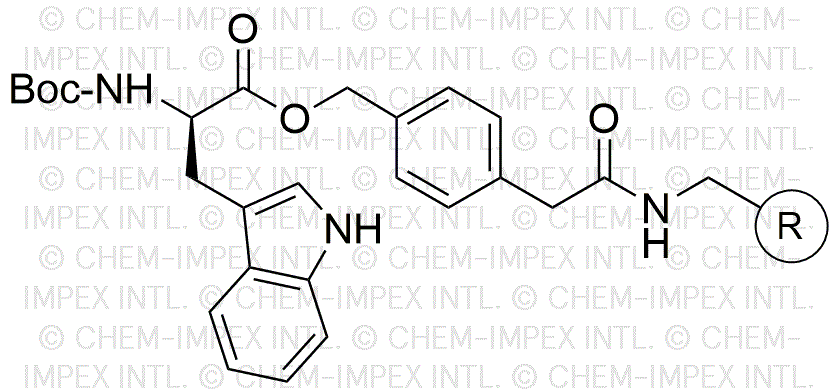|
Na-Boc-D-tryptophan 4-oxymethylphenylacetamidomethyl is widely utilized in research focused on:
- Peptide Synthesis: This compound serves as a key building block in the synthesis of peptides, particularly in the development of bioactive peptides that can be used in pharmaceuticals.
- Drug Development: Its unique structure allows for modifications that enhance drug efficacy and selectivity, making it valuable in the design of new therapeutic agents.
- Bioconjugation: The compound can be employed in bioconjugation processes, linking biomolecules to create targeted drug delivery systems, which improves treatment precision.
- Research in Neuroscience: Due to its tryptophan component, it is used in studies related to neurotransmitter synthesis and mood regulation, aiding in the understanding of mental health disorders.
- Analytical Chemistry: It is utilized as a standard in analytical methods to quantify tryptophan derivatives, helping researchers ensure accuracy in their experiments.
General Information
Properties
Safety and Regulations
Applications
Na-Boc-D-tryptophan 4-oxymethylphenylacetamidomethyl is widely utilized in research focused on:
- Peptide Synthesis: This compound serves as a key building block in the synthesis of peptides, particularly in the development of bioactive peptides that can be used in pharmaceuticals.
- Drug Development: Its unique structure allows for modifications that enhance drug efficacy and selectivity, making it valuable in the design of new therapeutic agents.
- Bioconjugation: The compound can be employed in bioconjugation processes, linking biomolecules to create targeted drug delivery systems, which improves treatment precision.
- Research in Neuroscience: Due to its tryptophan component, it is used in studies related to neurotransmitter synthesis and mood regulation, aiding in the understanding of mental health disorders.
- Analytical Chemistry: It is utilized as a standard in analytical methods to quantify tryptophan derivatives, helping researchers ensure accuracy in their experiments.
Documents
Safety Data Sheets (SDS)
The SDS provides comprehensive safety information on handling, storage, and disposal of the product.
Product Specification (PS)
The PS provides a comprehensive breakdown of the product’s properties, including chemical composition, physical state, purity, and storage requirements. It also details acceptable quality ranges and the product's intended applications.
Certificates of Analysis (COA)
Search for Certificates of Analysis (COA) by entering the products Lot Number. Lot and Batch Numbers can be found on a product’s label following the words ‘Lot’ or ‘Batch’.
*Catalog Number
*Lot Number
Certificates Of Origin (COO)
This COO confirms the country where the product was manufactured, and also details the materials and components used in it and whether it is derived from natural, synthetic, or other specific sources. This certificate may be required for customs, trade, and regulatory compliance.
*Catalog Number
*Lot Number
Safety Data Sheets (SDS)
The SDS provides comprehensive safety information on handling, storage, and disposal of the product.
DownloadProduct Specification (PS)
The PS provides a comprehensive breakdown of the product’s properties, including chemical composition, physical state, purity, and storage requirements. It also details acceptable quality ranges and the product's intended applications.
DownloadCertificates of Analysis (COA)
Search for Certificates of Analysis (COA) by entering the products Lot Number. Lot and Batch Numbers can be found on a product’s label following the words ‘Lot’ or ‘Batch’.
*Catalog Number
*Lot Number
Certificates Of Origin (COO)
This COO confirms the country where the product was manufactured, and also details the materials and components used in it and whether it is derived from natural, synthetic, or other specific sources. This certificate may be required for customs, trade, and regulatory compliance.


